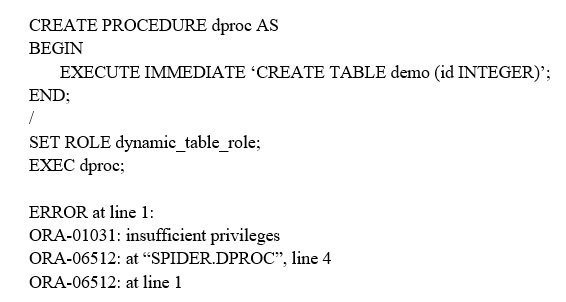Which two blocks of code execute successfully?
The code block in option A defines a subtype `new_one` as a BINARY_INTEGER within the range 0 to 9 and assigns a value of 0 to `my_val`, which is valid and will execute successfully. The code block in option E defines a subtype `new_one` as a NUMBER with precision 1 and scale 0 and assigns a value of -1 to `my_val`, this is also valid and will execute successfully. Other options contain errors: Option B requires an initialization for the NOT NULL constraint, option C exceeds the precision for NUMBER(2,1) by trying to assign 12.5, and option D requires an initialization assignment for the NOT NULL constraint.
Which statement is correct about DBMS_LOB.SETOPTIONS and DBMS_LOB.GETOPTIONS for SecureFiles?
DBMS_LOB.SETOPTIONS performs operations on individual SecureFiles but not an entire column. This procedure allows enabling or disabling compression and deduplication settings on a per-LOB basis, thereby overriding any default settings specified at the column level. Consequently, the operation does not apply to the entire column, but targets specific LOBs within the SecureFile.
You are designing and developing a complex database application built using many dynamic SQL statements. Which option could expose your code to SQL injection attacks?
Not validating parameters which are concatenated into dynamic SQL statements could expose your code to SQL injection attacks. This vulnerability arises because malicious users can inject harmful SQL code via the parameters if they are directly concatenated into the SQL statements without proper validation and sanitization.
Examine this code executed as SYS:

Examine this code executed as SPIDER and the error message received upon execution:

What is the reason for this error?
Privileges granted through roles are never in effect when running definer’s rights procedures. When a PL/SQL procedure is created with definer's rights, it executes with the privileges of the owner of the procedure, and only direct grants are recognized, not roles. Therefore, the error occurs because the CREATE TABLE privilege granted to the dynamic_table_role is not being recognized in the context of the definer’s rights procedure.
Which codes executes successfully?
The correct answer is A. The package definition and body are correctly created, and the procedure uses the record type correctly. The anonymous block declares a record of this type, assigns values to its fields (though there is a typo: it should be '1_rec.price' not '1_rec_price'), and then calls the procedure correctly using EXECUTE IMMEDIATE with the USING IN OUT clause. All other options contain syntax or logical errors that would prevent them from executing successfully.